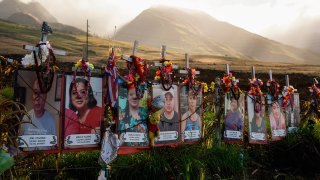
The last of the 100 known victims of the wildfire that destroyed Maui's historic town of Lahaina in August was identified Friday as a 70-year-old woman whose husband, sister and several other relatives also died in the fire.
Maui police said they identified the victim as Lydia Coloma. Her husband, along with a sister, brother-in-law and a niece and nephew, also died in the fire, said her sister-in-law, Tina Acosta, in Honolulu. Coloma was from the Ilocos Sur province in the Philippines, Acosta said, adding that she didn't know why the final identification took so long.
“We were waiting,” she said.
Identifying those who perished in the deadliest wildfire in the U.S. in more than a century has been a long, arduous process. Forensic experts and cadaver dogs have had to sift through ash searching for bodies that were possibly cremated, and authorities have been collecting DNA samples from victims’ family members.
Get top local stories in Philly delivered to you every morning. >Sign up for NBC Philadelphia's News Headlines newsletter.
The DNA testing allowed officials in September to revise the death toll downward, from 115 to at least 97. The toll rose slightly over the next month as some victims succumbed to their injuries or as police found additional remains.
The number of those who remain unaccounted for has also fallen — to just a few from a previous high of nearly 400, according to the Maui Police Department.
Photos: Deadly Wildfires Devastate Maui's West End
U.S. & World
Stories that affect your life across the U.S. and around the world.
The victims ranged in age from 7 to 97, but more than two-thirds were in their 60s or older, according to Maui police’s list of known victims. Several were residents of a low-income senior apartment complex.
Authorities reopened the burn zone to residents and property owners who lost homes while urging returning residents not to sift through the ashes for fear of raising toxic dust.
Authorities began clearing debris from residential lots this month. The waste is being wrapped in thick industrial plastic before the Army Corps of Engineers takes it to a temporary debris storage site south of Lahaina.
The disaster devastated Maui and Hawaii more broadly. Caught in a hellscape, some residents died in their cars, while others jumped into the ocean or tried to run for safety.
The cause of the fire is still under investigation. It may have been sparked by downed power lines that ignited dry, invasive grasses. An AP investigation found the answer may lie in an overgrown gully beneath Hawaiian Electric Co. power lines and something that harbored smoldering embers from an initial fire that burned in the morning and then rekindled in high winds that afternoon.
The blaze destroyed more than 2,000 buildings, most of them homes, and is estimated to have caused $5.5 billion in damage.
Nearly six months after the blaze, about 5,000 displaced residents were still living in hotels or other short-term accommodations around Maui. Economists have warned that without zoning and other changes housing costs in already expensive Lahaina could be prohibitively costly for many after rebuilding.



